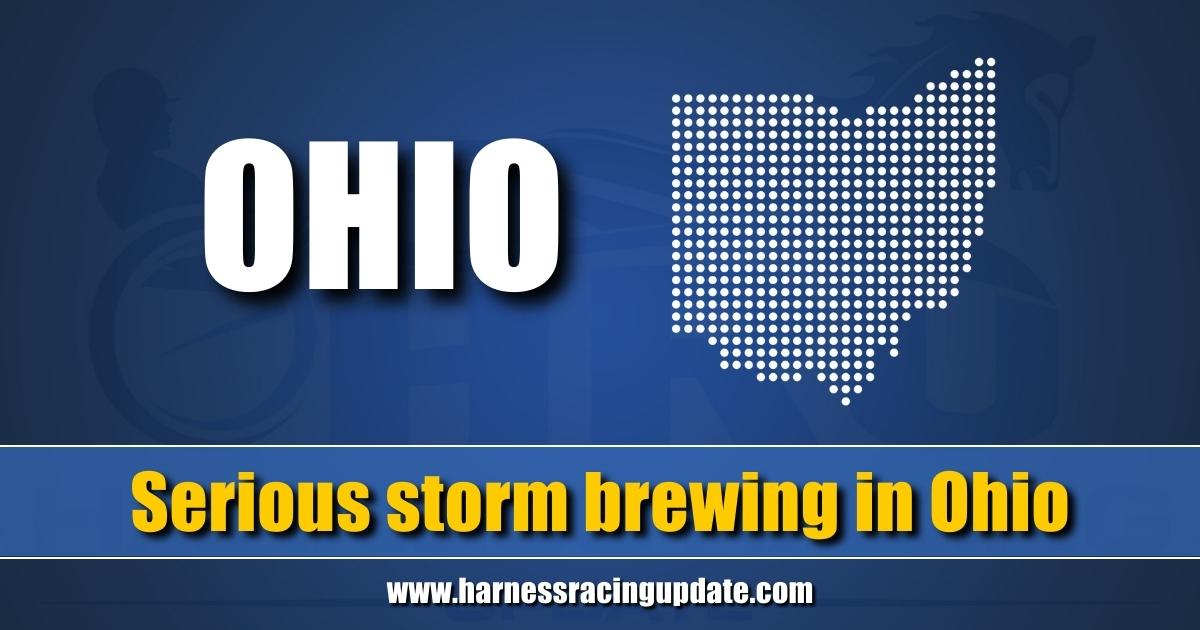

Serious storm brewing in Ohio
Of each dollar paid in Ohio purses last season, only 15.2 cents of it came from pari-mutuel play. The rest came from racinos, which creates an untenable long-term situation for Ohio horse racing.
by Bob Roberts
What you are about to read is a scenario that the participants — bettors, the backstretch bunch, breeders, suppliers, and just plain old fans of Ohio horse racing — should pray never unfolds. But you never know.
The year is 2030. It’s 9 a.m. on Monday (June 10), and the smell of breakfast is in the air. But there is a problem. Not a single table or a stool at the long counter is available at the Past Time Café on Perry Street. The wait to start a very special day with a stack of pancakes and a side of bacon spills out the screen door and onto the sidewalk. A waitress says it could be 20 minutes.
All the famished can do is pull the day’s program out of their back pockets or purses and get in a little handicapping.
What’s going on? Why such a crush? Pari-mutuel pace and trot analysis in a breakfast line?
The countdown is on. In just four hours, the first of 120 afternoons of rich, big stakes Ohio harness racing will commence at the Paulding Fairgrounds here in northwest Ohio. There isn’t a purse under $40,000. The feature goes for $75,000.
The entry box was stuffed.
How is all this possible? There was a death in the racing family, and money is available after the reading of the will. Specifically, there were seven deaths; the Buckeye State’s four harness tracks and three thoroughbred pari-mutuel raceways.
They all ceased operating in 2028, starved by a lack of attention by the permit holders and horsemen organizations, and a cold shoulder from horseplayers, many of them turning to slots and sports betting.
But the harness folks, a bit more rooted in the state due to their strong breeding program and network of county fair tracks, cut a deal with the state’s casinos and video lottery terminal palaces to get a percentage of the net win to power purses on the soon to be baptized super fair circuit.
More than 70 of Ohio’s 88 counties will present race programs in 2030, with the legendary Little Brown Jug at the Delaware County Fair, the bejeweled centerpiece, featuring several million-dollar races.
And what of the proud and majestic thoroughbred? Its calendar, that once covered nearly all 52 weeks, has been reduced to one day of racing at the Van Wert County Fair, where triumphant jockeys are handed a pork tenderloin sandwich in the makeshift winner’s circle. Adding insult to the injury of losing nearly 300 days of racing, all eight of the Van Wert dashes are for horses bred in nearby Indiana, only because the Ohio breeding program, never an artistic success, has all but faded away.
Could this sorrowful pari-mutuel nightmare occur? Maybe. Or could those who hold the keys to racing’s future take a long hard look at the plunging numbers and dedicate themselves to pumping life back into the industry with improved awareness, marketing and promotion.
Figures supplied by the Ohio State Racing Commission reveal an industry on life support through its reliance on a generous cut from the more than 10,000 racino video lottery machines, as well as revenues from the four stand-alone casinos, all of it fueling the purses at the seven Buckeye racetracks. The VLT pipeline was turned on for the first time in 2012 and has proven to be a gusher for horsepeople.
In 2022, purses paid totaled $129,447,193. Of that, $109,772,612 came from the nine to 11 per cent the horsepeople receive from the racinos and as well as a cut of casino winnings. Just $19,674,581 was generated by people betting on the races.
In dollars and cents, it means that racing can’t support itself alone unless it wants to offer ridiculously low prize money. Of each dollar paid in purses last season, only 15.2 cents of it came from pari-mutuel play. A stark example of the dependency on games of chance is that when Thistledown, or any other track, offers a $24,000 purse, only $3,648 comes from horseplayers pushing money through the pari-mutuel windows.
“I’ll be blunt, it’s really cloudy here,” said Scott Borgemenke, chairman of the Ohio State Racing Commission. “It’s a Category 5 storm that we hope we can diminish to a Category 3. The wagering handle keeps going down and the age of the fans keep going up. We might be a pandemic away from zero.”
Borgemenke isn’t sure where the sport is headed.
“It’s not good for the horseplayer,” he said. “It appears that the permit holder has given up and the horsemen, well, their eye is on winning a purse. It seems nobody cares about the guy watching the races. The sport has distanced itself from the consumer and that’s dangerous.”
According to the Ohio State Racing Commission’s annual report, wagering in the state, at least on live racing, has plunged from a high of $628.7 million in 1998 to $113.3 million in 2022. However, that comparison is a bit deceiving. The 2022 numbers do not include full card simulcasting totals.
A sign that the pari-mutuel foundation is cracking is that Thistledown horsepeople, which recently concluded a 10-year contract for a healthy share of the VLT profits, signed a new deal that covers only the next four years.
“I’m afraid I understand why they [management] won’t commit to beyond four years,” said Borgemenke. “Even though the harness industry is in much better shape than the thoroughbreds, overall, it’s not a healthy situation.”
Harness Racing Update interviewed several of the leading voices in Ohio to get their thoughts on the current health and future of the sport they love.
Despite the swirling storm clouds, Renee Mancino, executive director of the Ohio Harness Horsemen’s Association, is optimistic.
“I’m positive that if we advertise, market and promote, we’ll bring the people in,” she said. “We have over 100 stallions in 35 Ohio counties and we are No. 1 in producing standardbred foals in North America eight of the last nine years. We’re attracting owners from out of state, horsemen from out of state. We have full
entries. There are always overflow horses in the box. I’m bullish on Ohio.”
The OHHA, under Mancino’s direction, has been aggressive in its attempt to position harness racing in a good light. The Sept. 9 Ohio Sires Stakes Night of Champions from Scioto Downs was seen nationally for three hours on Fox Sports, and the OHHA honored its roots by broadcasting full programs live online from more than 60 Buckeye county fairs.
As for racing’s marriage with racino management, Mancino wants to enhance the relationship.
“The partnership was put in place by Gov. Kasich and I think we can make it more of a profit center than what some others think,” she said. “Our goal is to be a good partner with management. We need to be mainstream with these products.”
Dr. John Mossbarger, president of Ohio breeding giant Midland Acres, and a member of the board of directors for the Hambletonian Society, is pragmatic in his view of racing’s future.
“We’re coming off a record Jug sale in Circleville [269 yearlings fetched $8.2 million] where the average price was over $30,000, but it’s a difficult time in Ohio,” Mossbarger said. “We know a lot of the racinos don’t want us, so perhaps they can lease us the tracks to run the racing. That way, the burden will be put on the horsemen.”
Mossbarger believes that equally important to breeding a good horse is keeping the industry’s focus on those who inhabit the Ohio Statehouse in Columbus.
“Talking to our legislators should be our No. 1 priority,” he said. “We must have a grass roots approach. It can only help us.”
On the thoroughbred side, Brian Raimonde, president of the Ohio Thoroughbred Breeders and Owners (OTBO) see the glass as being more half full then empty.
“I truly believe the market in Ohio is good,” he said. “Purses have strengthened and breeding is good. However, HISA (Horseracing Integrity and Safety Authority) is hurting everything.”
Raimonde believes the sport needs to attract new faces, especially young people, but that the OTBO is financially handcuffed.
“We lost our funding from the [Ohio] HBPA (Horsemen’s Benevolent & Protective Association) within the last year,” he said. “That’s $75,000 we counted on. Our horse sale helps us make up the loss, but just by a little bit.”
Mark Doering, veteran Thistledown owner/trainer and a vice president of the Ohio division of the HBPA, is extremely concerned about the health of thoroughbred racing in the state.
“Several things worry me,” said Doering. “The costs associated with HISA and HIWU (Horseracing Integrity & Welfare Unit, which administers the rules of HISA), is eating us alive. We’re talking millions of dollars.
“Then there is the lack of marketing and promotion of our sport. At our HBPA board meetings, we’ve talked of spending money to increase the awareness of racing, but what good would that be if people showed up to see how little management cares about the product? It would be a bad experience and a waste of our money.”
Doering believes there must be an agreement and shared financial responsibility between horsepeople and management to lift racing’s level in its bid for a share of the entertainment dollar.
“Without a deal, this will remain a disheartening situation,” he said. “I came to Thistledown in 1995 and thought it was a little paradise. Today, you can’t even get a hot dog or a box of popcorn.”
How can racing boost awareness, interest and wagering in its product? There is no shortage of opinion.
Unlike the simplicity of tapping the keys on a video lottery terminal or picking one team or the other at a sports betting kiosk, betting on the horses, unless one fancies names or numbers, requires a bit of brainwork.
All Ohio tracks could offer free past performances on their own races on websites and at program stands. The NFL, NBA or MLB make team and individual player statistics free to the public, why not racing?
To further assist horseplayers — both novice and seasoned — tracks should upgrade their video presentation to include expert talking heads, drivers, jockeys, trainers and owners.
Ohio’s other six tracks could take lessons from Northfield Park, easily the state’s No. 1 track in handle, as well as the leader in marketing and promotion. It offers free seminars, tip sheets, bet matching and weekly free $1,000 handicapping contests.
Since such a small portion of wagering takes place on track in Ohio, why not offer a 10 per cent bonus (in the win, place and show pools) on any wager made inside the facility? Bet $20 on a horse that pays $8.80 and receive $96.80 instead of $88.
Of course, these types of innovations, as Doering suggests, would work best as a partnership between management and horsepeople.
Bill Murphy, the former general manager of Thistledown before accepting a similar post at Gulfstream Park, is disappointed in both the Ohio horsemen and track management.
“President Biden likes to quote his father who said, ‘Don’t tell me what you value. Show me your budget – and I’ll tell you what you value,’” said Murphy. “Well, from what I see, neither the horsemen nor the racino people have much of a budget for promoting racing. If nothing changes, I can’t see the sport surviving in Ohio.”















